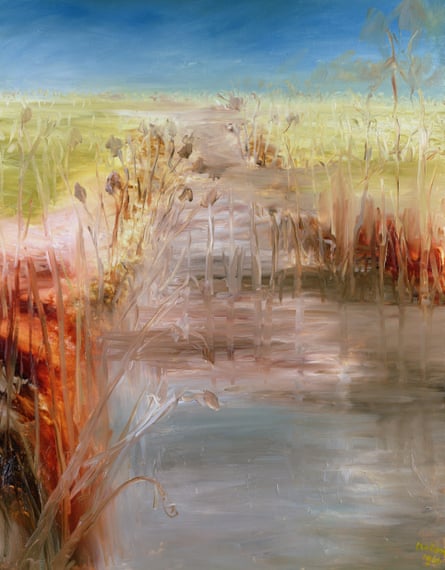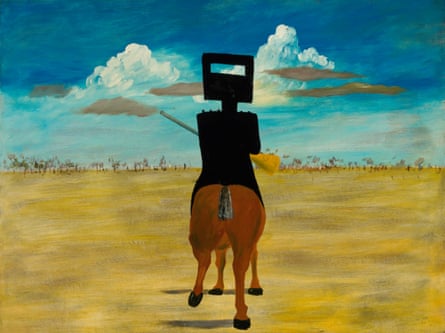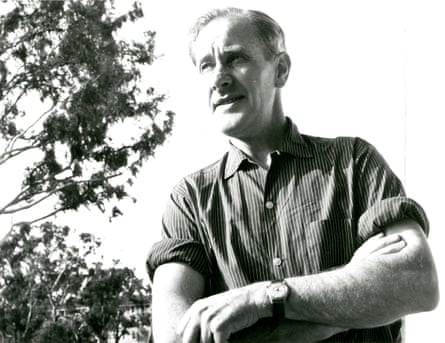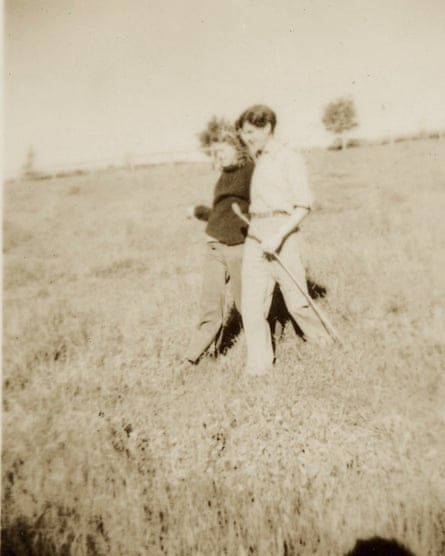A modest exhibition of slate paintings will not be the grandest tribute paid to Sidney Nolan in his centenary year. But it is perhaps the most poignant. Australia’s greatest 20th-century artist painted them in the early 1940s while in the early throes of his decade-long affair with Sunday Reed, and living in a decidedly modern menage with Sunday and her husband John. Heide, the Reeds’ six-hectare rural home outside Melbourne, is now a museum of modern art, and it was there the slates were displayed, a short walk from the kitchen garden that Nolan helped dig and the dining room where he created his famous Ned Kelly series depicting Victoria’s most notorious bushranger.
The slates, experimental pieces by a young man still finding his style, bear repeated images: a bird seeks shelter in an almond tree (Sunday’s nickname for Nolan was Robin Redbreast); boats hover, primed for escape. There are paradise gardens complete with Sunday-shaped angels, and a serpent of doom. Even then, Nolan seemed to anticipate the tragedy to come.
In his many years as a member of the British arts establishment – friend to Kenneth Clark and Benjamin Britten, designer of ballets and operas, knight of the realm – Nolan rarely mentioned the Reeds or Heide. Yet he owed everything to them. His paintings of Kelly – an instantly recognisable black-helmeted outlaw captured in a sequence of almost absurdist scenes of ambush – were, he once said, “angry, violent pictures” inspired by that time. “From 1945 to 1947 there were emotional and complicated events in my own life. It’s an inner history of my own emotions.”
Throughout 2017, exhibitions in London, Birmingham, Chichester, Melbourne and Sydney will celebrate this most innovative of painters of the Australian landscape, as well as championing his later, lesser known works. His studio at The Rodd, the farmhouse in Herefordshire where he spent the last decade of his life, will open to the public for the first time in May. Like his heroes Picasso and Matisse, Nolan never stopped experimenting; the giant spray-can abstracts he created in his 70s surprised many who came to visit the home of Sir Sidney.

The story of his years at Heide has, until now, been told only from Nolan’s point of view. Wealthy society folk, the Reeds built it as a place to house and nurture the avant-garde art scene of which they were both patrons. Nolan called it “a bleak period in my life” and a succession of 20th-century art critics and historians repeated his version – of an oppressive, volatile environment that left him forever damaged. In 1971 Nolan published a book of poetry, Paradise Garden, which depicted his former lover and her husband as predatory figures.
“It’s almost like he was trying to say he was abused in those poems,” says Kendrah Morgan, who with Lesley Harding curates the Heide Museum of Modern Art. “But you can see from his letters that he was a willing party. He loses perspective. Time and distance distorts it.” Drawn from hundreds of pieces of correspondence, as well as unpublished interviews with friends and collaborators, Morgan and Harding’s biography of the Reeds, Modern Love, has shone a new light on not just their lives, but also that of their protege.
Sunday Baillieu was an heiress, the daughter of one of the richest businessmen in Melbourne. Before she met John Reed she had endured a three-year marriage with an abusive philanderer, Leonard Quinn. He had given her gonorrhoea, and Sunday – pregnant, abroad and alone – had a brutal hysterectomy and was unable to have children.
Many of Australia’s leading artists – including Sam Atyeo, Albert Tucker, Joy Hester and Mirka Mora – benefited hugely from the patronage of her and John, who regularly fed them, housed them, and bought and promoted their work. But the heightened passions of the Heide Circle, whose intellectual discussions and bedhopping consciously echoed those of the Bloomsbury set, was sometimes too much to handle.

It was soon after the breakup of the Reeds’ first menage with Atyeo (John was, according to Modern Love, voyeur rather than participant) that Nolan met the couple. He had just married and was providing for his family by working on an asparagus farm, but was convinced that his future lay as a poet or an artist. When a Melbourne critic recommended he show his drawings to a lawyer with an interest in the avant garde, he talked his way into John Reed’s office: Reed, impressed, invited the 20-year-old to dine at Heide that night.
What followed is well chronicled – Nolan’s increasing attachment to Heide and the breakup of his marriage, engineered, it seems, by John Reed himself, who told Elizabeth Nolan she was ruining her husband’s future career. Poet Simon Mundy knew Nolan in his final decade, and has just published a short volume on him: he believes Nolan was “emotionally passive” throughout his life. “Sid positioned himself into areas that got quite complicated and then wished he hadn’t,” says Mundy. “And then blamed everybody but himself.”
When Nolan moved into Heide, he still didn’t know if he wanted to write or paint: Michael Keon, a journalist who was also one of Sunday’s lovers, recalled how she had “sat him down with paints and paper, then read to him in French and asked him to paint or write what he felt”. It was Sunday, too, who encouraged Nolan’s reading habits and cultivated his thinking.
“He underwent a transformation at Heide,” says Morgan. “The first letters from Nolan to the Reeds aren’t illiterate but they don’t give any indication of the sophisticated mind that he was when he left. It’s ‘Dear Mr Reed thank you for your interest in my work’ – it’s very basic.” By the time he left, the letters are “incredibly cryptic, intense, opaque, philosophical”, says Harding. “He had really flowered.”

In the Reed archive is a diary kept by Sunday in 1943. Its mostly blank pages record only her interactions with Nolan, who had been conscripted after the bombing of Darwin and posted to an army supply corps 300 miles away in the Wimmera, Victoria. Alongside her notes of phone calls and visits are records of the painting materials she sent him on a regular basis, and the pictures he sent home to Heide. Sunday had encouraged him to turn to landscape as a subject – a deeply unfashionable idea for the modern artist – and the paintings he created there established his later visual style.
Nolan’s series of Wimmera paintings were given to the National Gallery of Victoria by the artist in 1983; this year, for the first time, they will be given an exhibition of their own. “The Wimmera is wheat country but also where the Little Desert is – low rainfall, stunted bush,” says David Hurlston, the NGV’s senior curator. “It’s very different to the lush areas you would expect to see in paintings at that time.” Its flat, vacant expanse forced Nolan to find new ways to depict the land of his birth, and his interest in its mythology led him to Kelly.
There were many reasons why Nolan may have identified with Kelly – the artist liked to see himself as an outsider and a rebel. But in 1946 when he began the series, there was a more immediate parallel: Nolan was a fugitive from the law. With the prospect of frontline action in Papua New Guinea an increasing reality, he had tried to earn a medical discharge from the army – and after failing, had deserted.
It was during this period – harboured by the Reeds under the pseudonym of Robin Murray – that Nolan began painting the Kelly legend. Sunday was at his side throughout, priming his canvases, mixing his paints and framing his work; Janine Burke even claimed, in her 2004 book Heart Garden, that she painted some sections, including the red-and-white checked floor in The Trial. She certainly agreed to be the subject of more than one, and the sexual shenanigans at Heide are alluded to throughout the series.
When the affair finished a year later, Nolan left the paintings to Sunday, writing to John: “I do not even feel that the Kellys belong to anyone else other than Sun.” (She donated them, in 1977, to the National Gallery of Australia in Canberra where they remain).
Morgan and Harding’s book suggests that there wasn’t room in the relationship for Nolan after the Reeds agreed to be full-time guardians to Sweeney, the three-year-old son of his fellow Heide artists Albert Tucker and Joy Hester. “Once Sweeney had been introduced into the family unit, the menage didn’t have a future as far as any of them were concerned. Nolan was looking for an out,” explains Harding.

The young artist travelled to Queensland with the poet Barrett Reid (one of Modern Love’s more controversial theories is that Reid, too, was sexually involved with Nolan); Sunday had a nervous breakdown following his departure. Six months later Nolan was engaged to John’s sister Cynthia. “Cynthia was John and Sunday in one person, if you like,” says Morgan. “She was John’s sister and she looked like Sunday … Freud would have had a field day.”
Cynthia and Nolan only saw the Reeds once more – a visit on the day after their marriage that ended in a row. When Nolan’s fame increased – due to the Reeds’ unstinting and generous promotion of his Kelly series all over the world – the artist took umbrage at their reluctance to release early works they believed to be theirs, part of Nolan’s contribution to communal life at Heide. John made repeated attempts to heal the rift, but Nolan refused all contact. “It probably really angered him that they would never say any but positive comments about him and his work,” says Morgan. “Their love for him remained.”
He was a myth maker,” he adds. “Not only in his paintings but in the way he created a public image.” And so it was with the Reeds, whose part in his success he attempted to redact from his history. “At times in his life he would completely gloss over his 10 years at Heide and talk about the Reeds in a very detached manner, as though they were just some remote benefactors – not at all that he’d been living in a close sexual and patron-client relationship with them.” He never invited them to the openings of his exhibitions – and even vetoed their attendance at one they had arranged themselves.

Nolan’s elevation from St Kilda wide boy (his father, a tram driver, also ran an illegal bookmaking business) to establishment figure may have contributed to his desire to downplay his bohemian past. His romance with Sunday was the defining one of Heide, but Nolan had other lovers, and Morgan and Harding’s research revealed that Sunday wasn’t just sleeping with other men, but other women, too. “We thought we might write a book that took the sensationalism out of it all,” says Morgan. “But actually we found the Reeds’ lives were more experimental and more complicated than we had anticipated.”
Perhaps the self-made Nolan did not care to feel too beholden to other friends for his success, either. Max Harris, whose relationship with Nolan had something of a competitive edge, once called his personality “as open as death row at Sing Sing. He manages his life as [if] it were a one-man MI5 … Although he can suffer sporadic and painful attacks of friendship, he gets over them quickly.”
Those who knew him later in life are kinder in their assessment. John Tooley, the former director of the Royal Opera House, first met Nolan in 1955. “I didn’t find him particularly hard to get to know,” says Tooley. “He had the great art of being friendly with all the right people – Kenneth Clark gave him a tremendous amount of help – and Sidney for his part never drew breath. He was constantly active, he wanted to meet people, wanted to see things. He just knew that round the corner there were always things that would interest him.”
Mundy meanwhile, believes that while his work can seem bitter and angry, “I don’t think he apportions blame, he just shows things in a very unvarnished and vicious way. He is being as mean to himself – in private and in his pictures. Kelly’s black mask is a prison as well as a defence.”
Among the slates at Heide was one with a message scrawled in chalk on the back. “Goodbye my darling,” Sunday had written, followed by a string of kisses. A letter from John to Max Harris in 1964 asserts that “our feelings of love for him have remained essentially the same over the years”.
But it is another letter, written by her friend Mirka Mora, the acclaimed muralist, which points to their enduring place in the artist’s work. “Dear Sunday, the Nolan painting is so beautiful,” wrote Mora. “And I realise it is not the painter who is the genius – for he is merely an instrument – but the person who sees it is a great painting … You are the genius for having seen at the time how beautiful the Nolan paintings were.”
- Transferences: Sidney Nolan in Britain is at Pallant House Gallery, Chichester, until 4 June. pallant.org.uk. It is part of a year-long programme of centenary exhibitions and events across the UK organised by the Sidney Nolan Trust. sidneynolantrust.org

Comments (…)
Sign in or create your Guardian account to join the discussion